Glimpses: A Cultural Heritage
An ancient repository of the arts, the culture of Jammu & Kashmir is closely linked with the lifestyles of its people. In the aesthetic environment of their homesteads, all items of daily use and all furnishings are created with the help of cottage industry crafts, mostly within the house itself. The beautiful carpets, the carved walnut furniture, the delicately embroidered shawls, papier mache objets d' art, silver and gold jewellery and the beautiful samawar are all expressive of the art the people of the region bring to their daily lives.
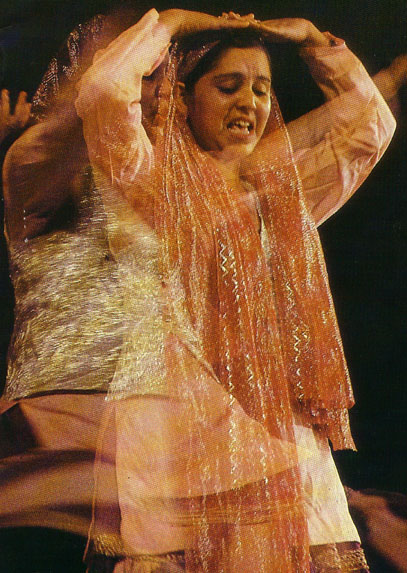
The communities are largely agrarian based, and in the simple village lifestyles of the people of the state, governed by changing seasons, adaptation to natural conditions has been an essential aspect. This then has dictated the proliferation of the cottage crafts, the development of a classic cuisine, and resulted in a strong faith in religion and in the simple religious beliefs of the people.
Though the state's artisans go back to several generations, the arts gained eminence with the advent of the Muslim rulers to the state. A great exchange took place between the two cultures of which historian Sir J. Marshall recounts, "Seldom in the history of mankind has the spectacle been witnessed of two civilizations, so vast and so strongly developed, yet so radically dissimilar, as the Hindus and Muslims, meeting and mingling together."
On the following pages are some aspects of the culture of the state now translated into a modern heritage.
Featured Collections
Music & Dance
Kashmir, since ancient times, has been known as a centre of art, literature and scholarship. The art of drama too draws ancient lineage here, its origins being traced to the Bhand, minstrels who moved from house to house entertaining valley dwellers. This later gave way to the Pather, a spectacle full of satire and humour. As elsewhere, early dance was based on religion and on the populist faith of good overpowering evil, as in the Dhamali.

Essentially, the dances of Jammu can be classified into four forms, mostly folk and community based, in character. The Bindloo and the Jagarna are both dances set to the theme of marriage and marital relationships. The Bhakhan details the joys and sorrows of lovers' meetings and partings. The Kud is a thanksgiving dance performed before the local deity. Other season-based dances are the Phummian, Bhangra and Dandaras.
It is in Kashmir that the folk-plays or Pathers are popular. Another notable dance is the Roff, performed by women on the occasion of Idd.
Popular songs are the Chhakri and the Hafiz Naghma. The music of Kashmir, Sufiana Kalam, combines elements of Indian and Iranian music, and the most popular instrument is the Santoor. Several rages and mukams are common to Kashmiri and Persian music.
Because of the rarified atmosphere of the Ladakh mountains, dancing and singing movements here are more subdued. On religious festivals and fairs, the Ladakhis don colourful brocade costumes and participate in community dances to the accompaniment of drums, shehnais and narsinghas. Scenes from myths and legends are enacted and in simplistic portrayals the dancers wear large and exotic papier-mache masks depicting forms evil and good. Like elsewhere in Buddhist settlements, the snow-lion dance is popular and brings to the state a carnival-like ambience.
Musical instruments include drums, among them the Damaru, Shnavuk and Daman, and the Shankh or conch shell and the brass Surna which is held by two lamas while the third blows into it.
Festivals
A time of joy, a time to celebrate, and there's an expression for every mood. Whether personal celebrations, or religious and social festivals, merrymaking and dancing are essential to them all.
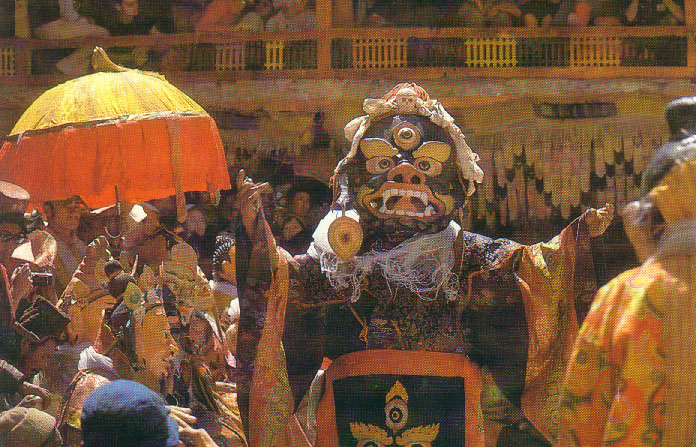
The grand spectacle of the annual Hemis festival
The annual dance-drama festival is celebrated all over Ladakh, and though best known at Hemis, is not exclusive to it. A much-celebrated event for the religious Buddhist Ladakhis, it is held on the birthday of Guru Padma-sambhava, a Buddhist missionary who spread the message of Lord Buddha in the Himalayan region. At Hemis, this July fest is held in the courtyard of the monastery and masked participants of the dance-drama are the major attraction. Successive troupes of lamas dressed in flowing, exquisite brocade robes and papier mache masks whirl in the constricted space to the tune of drums and oboe pipes.
In Jammu & Kashmir regions major festivals celebrated include the Sout or spring festival in March, Naw Warih on new year's day in March-April, Baisakhi, Jeth Ashtami, Har Nawami, Pun, Janmashtami, Kambari Pach and Dusserah, each with merrymaking and dance, and the observance of prescribed rituals.
Idd is celebrated with great eclat, new clothes are worn and the devout attend prayer meetings at mosques. Beyond the mosques, open grounds become fairs, and food and souvenir stalls spring up and do brisk business. It is said of Kashmir Hindus and Muslims "equally holding in reverence Hindu shrines and Muslim Khanqahs situated closely or almost in the same precints". Notable examples of this are the great Khanqah of Shah Hamdan, Kali Temple, Shah Sahib's Mosque, Ziyarat-i-Makhdoom Sahib, Hari Parbat and Madin Sahib.
Lifestyles
An ancient repository of the arts, the culture of Jammu & Kashmir is closely linked with the lifestyles of its people. In the aesthetic environment of their homesteads, all items of daily use and all furnishings are created with the help of cottage industry crafts, mostly within the house itself. The beautiful carpets, the carved walnut furniture, the delicately embroidered shawls, papier mache objets d' art, silver and gold jewellery and the beautiful samawar are all expressive of the art the people of the region bring to their daily lives.
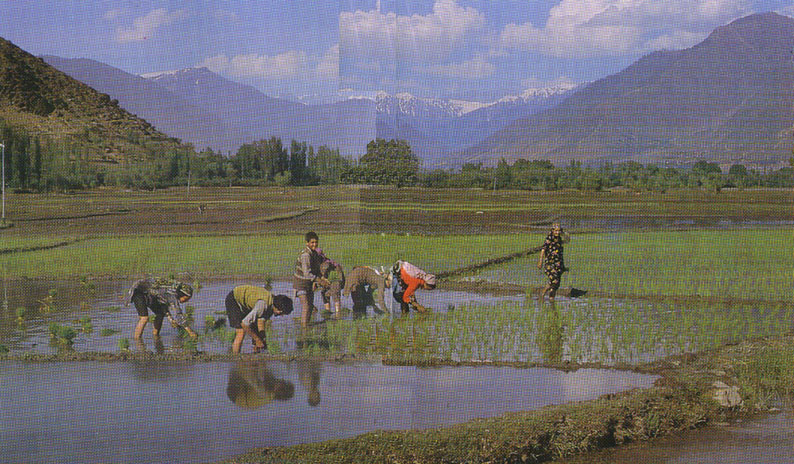
Planting rice in the paddy fields of the valley
The communities are largely agrarian based, and in the simple village lifestyles of the people of the state, governed by changing seasons, adaptation to natural conditions has been an essential aspect. This then has dictated the proliferation of the cottage crafts, the development of a classic cuisine, and resulted in a strong faith in religion and in the simple religious beliefs of the people.
Though the state's artisans go back to several generations, the arts gained eminence with the advent of the Muslim rulers to the state. A great exchange took place between the two cultures of which historian Sir J. Marshall recounts, "Seldom in the history of mankind has the spectacle been witnessed of two civilizations, so vast and so strongly developed, yet so radically dissimilar, as the Hindus and Muslims, meeting and mingling together."
On the following pages are some aspects of the culture of the state now translated into a modern heritage.
Culinary Art of Kashmir
The Wazwan is Kashmir's most formal meal: a ritual serving before the guest of all the food there is in the house. This taste of hospitality must in turn be fully appreciated by the guest, for the wazwan is not a simple meal but a ceremony. Hours of cooking and days of planning go into the making and serving of a wazwan. Normally restricted to occasions of celebration at homes, the wazwan experience includes table settings for groups of four on the floor where choice dish after dish is served, each aromatic with herbs and the fresh produce of the region.
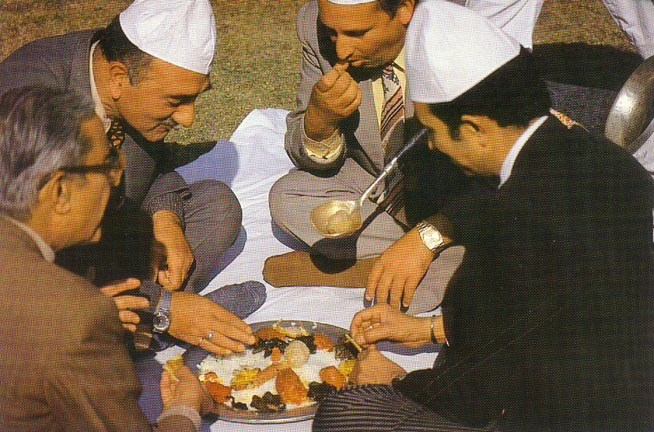
The traditional Wazwan meal is served in groups of four
First the Tash-t-Nari is passed around, and diners wash their hands from warm water in a samovar. The waza (chief cook) personally supervises each dish which comes out of his kitchen. even the ingredients for the meal have been hand-picked, and effort has ensured that each dish in this rich cuisine is one-of-a-kind. Choice delicacies such as Methi and Tabakmaaz, Roganjoshand Rista, and a variety of Kababs and vegetable preparations are served.
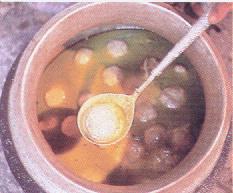
The Kashmiri delicacy, gushtaba, is served piping hot
The meal concludes with the Gushtaba, a very exclusive dish, and one that is never refused, Phirni for dessert and a cup of Kahwah, the green tea flavored with saffron, cardamom and almonds, and the wazwan is over - a meal that is an experience in Kashmiri hospitality.
Art and Crafts
Famed worldwide, the handicrafts of this region are executed with love and care, and are reflective of the interpretation of an aesthetic idiom.

Carpet weaving, one of Kashmir's most proclaimed arts
Kashmiri shawls have been renowned since several centuries and were once the pride of the French queen, Marie Antoinette. European ladies of court favoured these rare shawls. The most famous of these is the Jameawar shawl, made of soft pashmina wool and covered with fine and lacy embroidery. So soft is the Shahtush shawl, that it can be passed through a ring. And the embroidered phiran, a woollen cloak worn by women, too carries fine embroidery on it.
Equally well known is the art of carpetmaking with its exquisite Persian motifs handknotted in subdued, but warm colours, on wool and silk. Floor coverings also include namdas, gabbas and chain-stitch rugs made of thick wool and felted in the form of a rug.
Papier mache handicrafts from Kashmir make excellent souvenirs. Light in weight, yet colourful, and very artistic, these are interpreted lay artisans in the form of wall hangings, boxes, bowls, vases and lamps. Floral motifs occupy the surface of all papier mache handicrafts. Equally intricate is the carving on Kashmiri woodwork and furniture, chiefly walnut, but also in teak and rosewood. Patterned into heavy furniture, or into trays, boxes, tables and cigarette-cases, they make use of the chinar motif in the carving, just as the shawl-maker and the carpet--weaver.
Other Kashmiri handicrafts include silverware and jewellery, as well as silk fabrics, and woollen fabrics, chiefly patto (tweed) and Patti (milled blankets).
In Jammu, one can have rugs embroidered in chain-stitch patterns, or pick up wicker-work produce, a common sight in the markets. The latter is chiefly available as baskets, hampers and boxes. The chintzes of Samba too are well known. The Dogra Art Gallery has many samples of the miniature school of paintings of the region.
In Ladakh, the carpets, woven in wool, use Buddhist motifs, and a popular symbol is the dragon. Thankas are religious paintings made in monasteries, and framed in silk and brocade patchwork and use highly artistic skills. Masks, painted furniture, and everyday and religion-based objets d'art speak of an intricate art perfected over generations.



